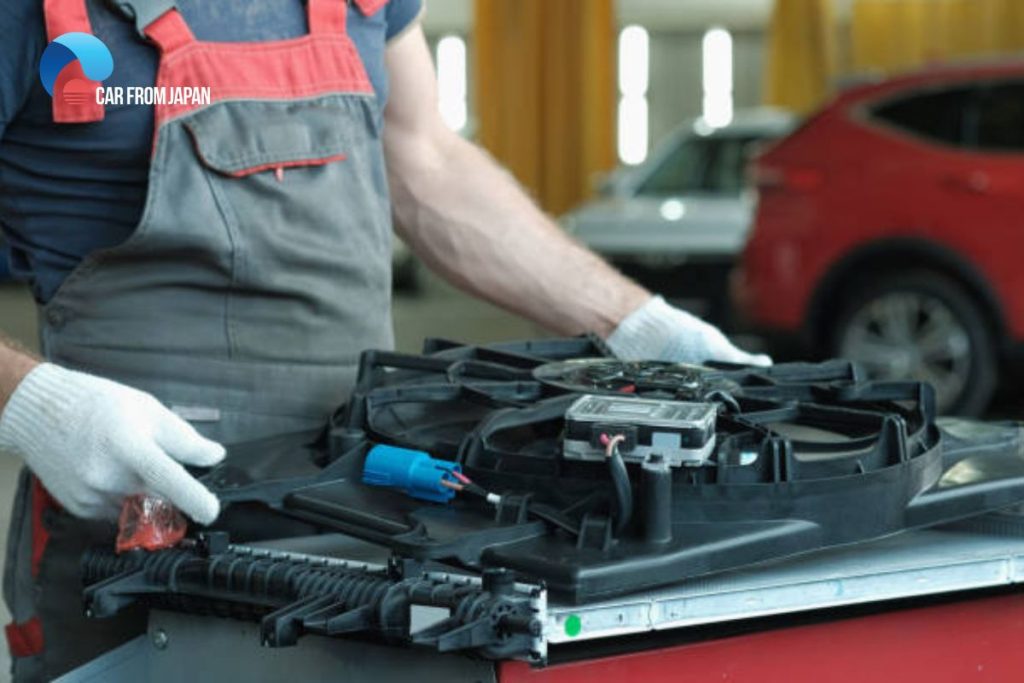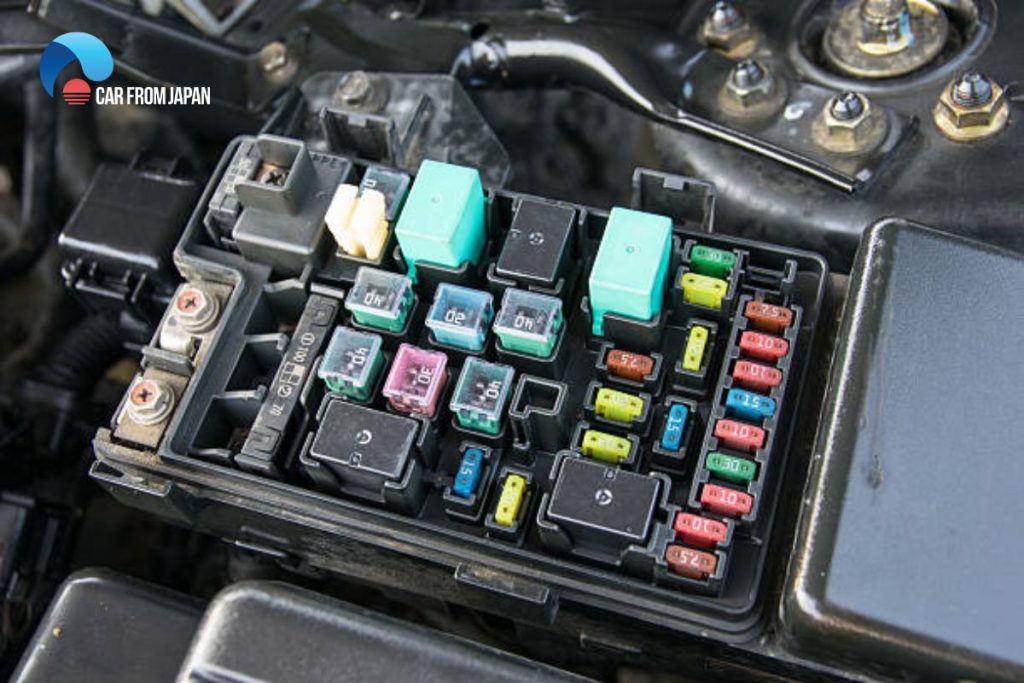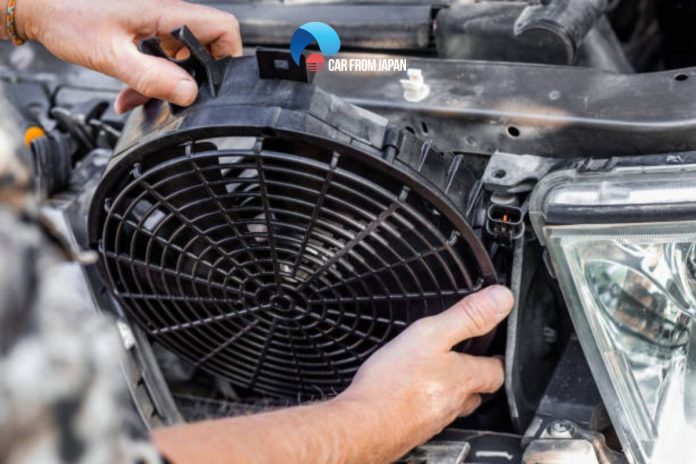Think of your car’s radiator fan like a bodyguard for your engine. When things get hot, it steps in to keep everything cool. But what happens when the bodyguard isn’t working? That’s what we’ll explore in this article, uncovering six common reasons why your radiator fan not working.
Contents
What Does A Radiator Fan Do?
The radiator is one of the engine’s multi-part cooling systems, along with the lubricating oil, which reduces friction,n and the exhaust system through which heat exits the combustion chamber.
When the thermostat in front of the engine detects that the engine reaches a dangerous temperature, the radiator then kicks in by releasing a mixture of water and coolant to quickly cool down the engine.
There is a sensor on the bottom passenger side of the radiator. It does the job of taking notes of coolant temperature.
It sends signals to the radiator fan to turn on when the temperature crosses 172°F. The fan should also turn on after switching on the air conditioner.
Positioned between the radiator and engine, cooling fans blow cooling air through the car’s radiator to cool down the heated water and coolant mixture that flows through the radiator.
Radiator Fan Not Working Symptoms

If you need to confirm if it’s in working order or not, you should turn on your engine and let your vehicle idle. The surest way to check it is by actually looking for the fan’s sound.
Turn the air conditioning to the maximum setting, this should spark the cooling fan to immediately come on. In older cars, this typically takes about 15-20 minutes for the engine to reach the right temperature.
All you have to do is lift the engine hood and listen closely for the sound of the fan. The best of modern cars have very quiet engines and so, it may not be easy to figure out the sound while you are inside the car.
If the fan comes on immediately when the air conditioning is operating at maximum volume, however it doesn’t run properly when the engine gets hotter later on, the radiator fan might not be working properly.
Can I Drive My Car If The Fan Is Not Working?
Yes, your car can still run without a radiator fan, but you never should drive it. Your vehicle’s cooling system is crucial to the engine’s performance and lifespan.
Every time your engine overheats, you’re causing tremendous damage to the engine.
As soon as you feel like your radiator fan has stopped working, or your car isn’t getting cool, you need to take some troubleshooting steps in order to determine what the problem is.
If you can’t figure it out, take your car to a mechanic right away so he can determine the issue.
Radiator Fan Not Working: Common Causes
What causes cooling fans not to come on? Here are 5 common problems that may be ailing your car’s radiator fan, making it defunct or inefficient:
A bad fuse

It is a very common problem that results in radiator fan failure: the fuse may burn off or simply fall off.
You will, though, have to consult the owner’s manual to find out where exactly you can find the fuse, but once you have, it is an easy task.
You will need to replace the fuse of the radiator fan in case it is not working or is absent.
Remember, if anything electrical in your car doesn’t work, your first checkpoint is the fuse. Here’s how to test the radiator fan fuses with a multimeter.
You have to check the voltage of a few fuses in the under-dash fuse box (numbers 3, 15, and 20) and under-hood fuse box (numbers 47 and 50).
Kick off the engine or switch the ignition key off to IG2. Set the multimeter’s meter to ‘20’ in the DCV section, as you will be testing 12V circuits.
The black multimeter probe will go to the negative battery terminal (for under-hood fuses) or a metal ground point on the car (for under-dash fuses).
Each fuse has two contacts where you have to touch the multimeter’s test probes to get the readings.
Touch the red probe to any of the two contacts and take the reading. The value should be around 12 volts.
No need to worry about recording the precise voltage reading because it varies due to several factors, including the alternator output and the charge in the battery. Touch the robe to another contact and take the reading.
What do the readings mean?
- 12V on both contacts. It means the fuse is working fine and you can just move on to check the next one.
- 12V one contact and 0V on the other. This is the sign of a blown fuse. You need to replace it.
- 0V on both contacts. It means the fuse does not have any power, which is only possible if the black probe is not properly connected to the negative terminal of the battery or grounded to a metal part. Detach the probe and then reconnect again to take readings.
Dead wires
If you see the engine heating but the radiator fan isn’t, the fan wires could be the culprit. Simply unplug both the wires, negative as well as positive.
The standard direct current they must put out is 12v (approx.). Take a voltmeter and check for the presence of current. If there is none in either or both, you will need to replace it.
You will be able to locate the fan relay under the hood. Check for current from the relay till the fan. That is where the current needs to flow.
If there is voltage present there, a fault in the fan is the reason for the radiator fan not working. It is then the fan that you will need to replace.
Broken fan clutch
The fan clutch is responsible for attaching the radiator fan to the engine and makes it work. If this clutch breaks, the fan won’t work.
It is the usual wear and tear over the years that may cause the springs in the clutch to corrode or even burn out. If you cannot find any other radiator fan problems, the clutch is most likely the cause.
Inadequate coolant level
Inadequate coolant level in the engine can also cause fan failure. Simply look at the coolant reservoir and check if the level is up to the requisite maximum mark. If not, simply fill it up to the mark and you’ll be good to go.
This is, in fact, one of the handiest maintenance tips that help you keep the engine as well as the cooling/heating system in great shape.
Defunct temperature sensor

A temperature sensor is the mechanism that decides when the radiator fan must kick into action. It does so by reading the temperature of the cooling system.
In case this sensor is out of order, the fan won’t be able to start working. You are likely to find this sensor in the thermostat cover.
You can try disconnecting the wires from and reconnecting them to the sensor, odds are that it’ll work. If not, you will have to have it replaced.
Bad radiator fan motor
If the problem of the radiator fan not working still persists, you can check the fan by connecting a different power source to it, that is direct battery power.
First, unplug the wiring connector. Check for any damage and clean the connector. Ensure that the wires are firmly attached and are not damaged.
Then, look at the wires and identify which ones are power wires and which ones are ground wires to avoid any confusion.
Next, connect the battery negative to the ground side of the fan connector, then connect the positive battery to the other wire.
You may need to look at your vehicle repair manual to see if your vehicle has a 4-wire terminal or three terminals, with two for power and one for ground wires. After being connected to the battery, your radiator fan should start running.
However, if your radiator fan doesn’t begin working with the direct power or runs at a very low speed, then you need to make sure there’s no damage to the terminal and test for incoming voltage.
If there is indeed incoming power, then the problem is a failing fan motor, and you’ll need to replace the fan motor as well.
Radiator Fan Replacement Cost
A radiator fan costs around $200 – $400. In addition, your mechanic would charge you $120 to $200 for labor cost depending on the make and model of your car.
Since the radiator is right at the front, your mechanic does not have to open any other component to remove the radiator fan.
In case you need to replace the fan motor as well, labor costs are estimated between $170 and $220 while parts are priced between $530 and $680.
How Long Does It Take To Replace A Radiator Fan?
Replacing a radiator is a laborious process, and the time duration varies depending on the skills of the service person.
A professional mechanic is unlikely to take more than 2 to 3 hours. It could take another 30 minutes to one hour because the process involves some extra services like removing coolant, broken belts, and a few other things, if necessary.
Experts may need two to three hours for the installation.
You may need more time depending on the conditions of some other parts. If the car is old, there is a possibility that electrical connectors and terminals are damaged and the fasteners are broken.
You will need to repair and replace these parts for the radiator to resume its operation. Some mechanics may also want to change the antifreeze and replace the radiator hoses.
Check out this video from Dmecanicien to learn how to fix a radiator fan not working!
In Conclusion
From simple fixes like blown fuses and faulty relays to more involved issues like a dead motor or wiring problems, they can cause your radiator fan not to work. However, whatever the reason, understanding the potential causes empowers you to take action. If you’re unsure about any step or encounter a complex issue, don’t hesitate to consult a qualified mechanic.



